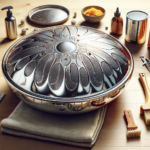<!DOCTYPE html>
<html lang="en">
<head>
<meta charset="UTF-8">
<meta name="viewport" content="width=device-width, initial-scale=1.0">
<title>Emotional Handpan Performances</title>
<style>
body {
font-family: Arial, sans-serif;
line-height: 1.6;
margin: 20px;
}
h2 {
color: #2c3e50;
}
</style>
</head>
<body>
<h2>Introduction to the Handpan: An Instrument of Emotive Power</h2>
<p>The handpan is a relatively new musical instrument that has captivated the hearts of many for its ethereal sound and emotive performance capabilities. Resembling an inverted steel drum, the handpan allows musicians to explore a rich tapestry of sounds and emotions with minimal effort. Each gentle strike on its surface can produce an array of tones that resonate deeply with both the player and the listener. This article will delve into the art of feeling as expressed through emotional handpan performances, exploring how this unique instrument serves as a conduit for deep emotional expression and connection.</p>
<h2>The Origins of the Handpan</h2>
<p>The handpan's origins trace back to the year 2000, when it was created by Swiss instrument makers Felix Rohner and Sabina Schärer of PANArt. Originally inspired by steel pans from Trinidad and Tobago, the handpan is uniquely designed to produce a resonant and soothing sound that stands out in the world of percussion. Its meteoric rise in popularity can be attributed to its enchanting soundscapes and the powerful emotions it evokes.</p>
<h2>Understanding Emotional Performance</h2>
<p>Emotional performance is not simply about playing notes; it is about delivering a story or a feeling through music. The handpan, with its circular layout and harmonic structure, allows performers to easily connect with their emotions and convey them to listeners. The instrument's tonal richness and dynamic response to touch make it particularly suited for producing expressive and emotive music.</p>
<p>In handpan performances, musicians often improvise, allowing their own emotions to dictate the music's direction. This improvised nature heightens the authenticity of the performance, creating a unique and personal experience during each session. For both the musician and the audience, this establishes a shared emotional journey that transcends mere auditory stimulus.</p>
<h2>The Role of Handpan in Healing and Meditation</h2>
<p>Beyond its use in musical performance, the handpan is commonly utilized in meditation and healing practices. Its calming vibrations and harmonic overtones are believed to promote relaxation and mental clarity. Handpan soundscapes are often incorporated into meditation sessions, allowing participants to explore their inner worlds and achieve a sense of tranquility.</p>
<p>The soothing qualities of the handpan have also found a place in therapeutic settings, helping individuals process emotions and relieve stress. Music therapists use handpans to create environments where clients can explore their feelings and move past emotional barriers. Through these therapeutic applications, the handpan's emotive power is harnessed for personal growth and healing.</p>
<h2>Techniques for Emotional Expression on the Handpan</h2>
<p>Handpan musicians employ various techniques to enhance their emotional expression during performances. One such technique is the careful use of dynamics—playing loud or soft notes to mimic the peaks and valleys of emotional experiences. By varying volume and intensity, performers can evoke feelings of joy, sadness, excitement, or contemplation.</p>
<p>Another technique involves exploring different rhythms and tempos to convey different moods. Slow and steady rhythms might create a meditative, serene atmosphere, while faster, more erratic tempos can evoke feelings of excitement or chaos. Further expression can be achieved by altering hand positions and striking techniques, exploring the full tonal range of the instrument.</p>
<h2>Influence of the Environment</h2>
<p>The environment in which a handpan performance takes place can significantly affect its emotional impact. Outdoor settings, such as a tranquil forest or a breezy seaside, may enhance the instrument's natural resonance, fostering a deeper connection with nature. Meanwhile, an intimate indoor setting can create a sense of closeness and introspection, allowing both performer and audience to focus on the subtleties of the music.</p>
<p>Performers often draw inspiration from their surroundings, allowing the ambient sounds and visual elements to influence their playing style and emotional output. This connection to the environment adds another layer of depth to the emotional experience, making each handpan performance distinct and memorable.</p>
<h2>Testimonials from Handpan Performers and Listeners</h2>
<p>Performers and listeners alike testify to the emotional impact of handpan music. Musicians describe a cathartic experience when playing, tapping into their emotions and sharing them through their performances. Some performers report reaching a meditative or trance-like state while playing, as the music flows naturally from their hearts through their hands.</p>
<p>Listeners, on the other hand, often recount feelings of peace and introspection when experiencing handpan music. The instrument's ethereal soundscapes tend to capture their attention, allowing them to lose themselves in the emotion of the moment. This shared experience between performer and audience not only enhances the emotional depth of each performance but also reinforces the communal aspect of music as an art form.</p>
<h2>Conclusion</h2>
<p>The handpan is a versatile and emotive instrument that offers musicians a unique medium for emotional expression. Its ethereal and soothing sounds serve both as a form of artistic exploration and as a tool for healing and meditation. The handpan's ability to forge deep emotional connections between performers and listeners makes it a compelling addition to the world of music.</p>
<p>Whether used as a therapeutic instrument or simply as a source of personal enjoyment, the handpan stands out for its capacity to tap into the profound depths of human emotion. As more musicians begin to explore the art of feeling through handpan performances, they continue to enrich our understanding of music as an emotional experience.</p>
<h2>FAQs</h2>
<h3>1. What is a handpan?</h3>
<p>A handpan is a musical instrument that resembles an inverted steel drum. It was developed in the year 2000 by Swiss instrument makers Felix Rohner and Sabina Schärer. Known for its soothing, resonant sounds, the handpan is often used in emotional performances, meditation, and music therapy.</p>
<h3>2. How is the handpan played?</h3>
<p>The handpan is played by striking its surface with the hands and fingers. Its tonal layout allows musicians to produce melodic and percussive sounds, often using a combination of strikes, taps, and rubs to create dynamic musical expression.</p>
<h3>3. Can anyone learn to play the handpan?</h3>
<p>Yes, the handpan is accessible to musicians of all skill levels. While mastering the instrument can take time and practice, beginners can quickly start producing beautiful and emotive sounds due to its intuitive layout and easy-to-play nature.</p>
<h3>4. What makes the handpan suitable for emotional performances?</h3>
<p>The handpan's harmonic and resonant qualities allow musicians to express a wide range of emotions effortlessly. Its tonal richness and dynamic range make it suitable for conveying complex emotional landscapes, while its improvisational nature fosters genuine, heartfelt performances.</p>
<h3>5. Where can I experience a handpan performance?</h3>
<p>Handpan performances can be found in various settings, from live concerts and festivals to intimate gatherings and online platforms. Additionally, many recording artists and musicians share handpan music through streaming services and video platforms, allowing for easy access to this unique musical experience.</p>
</body>
</html>The Art of Feeling: Delving Into Emotional Handpan Performances

Leave a comment




